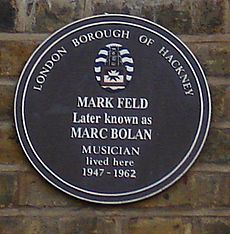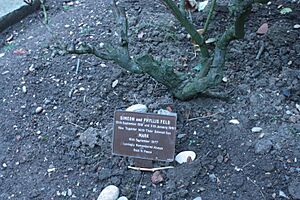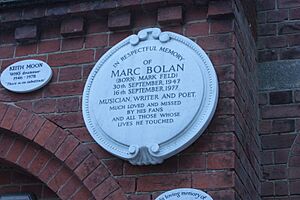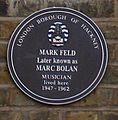Marc Bolan facts for kids
Quick facts for kids
Marc Bolan
|
|
|---|---|
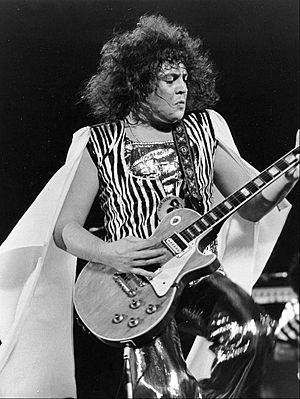
Bolan performing in 1973
|
|
| Background information | |
| Birth name | Mark Feld |
| Born | 30 September 1947 Hackney, London, England |
| Died | 16 September 1977 (aged 29) Barnes, London, England |
| Genres |
|
| Occupation(s) |
|
| Instruments |
|
| Years active | 1967–1977 |
| Labels | |
Marc Bolan (born Mark Feld; 30 September 1947 – 16 September 1977) was an English musician. He was a talented guitarist, singer, and songwriter. Marc Bolan became famous in the early 1970s. He was a leader of the glam rock music style with his band T. Rex.
Before T. Rex, he led the psychedelic folk band Tyrannosaurus Rex. They released several popular albums. Marc Bolan started with acoustic folk music. Later, he moved to electric rock. His band T. Rex had a big hit with "Ride a White Swan". It reached number two in the UK.
In March 1971, Bolan appeared on the TV show Top of the Pops. He wore glitter on his face while singing "Hot Love". This performance is often seen as the start of the glam rock movement. Many people called him the person who began it all. T. Rex's 1971 album Electric Warrior was very important. It helped kick-start the glam rock craze in the UK.
Marc Bolan died in a car crash just before his 30th birthday. A special memorial stone and statue were placed where he died. His music and guitar playing inspired many artists.
Contents
Early Life and First Steps in Music
Marc Bolan was born in Hackney, East London. He grew up at 25 Stoke Newington Common. His father was a lorry driver. His family later moved to Wimbledon, Southwest London. There, he fell in love with early rock and roll music. He enjoyed artists like Gene Vincent and Chuck Berry.
Marc went to Northwold Primary School. When he was nine, he got his first guitar. He started a skiffle band. He also played guitar in a trio called "Susie and the Hula Hoops". The singer was a young Helen Shapiro. Marc often played his guitar for friends at school. He was expelled from school at 15.
After school, Marc briefly worked as a model. He was a "John Temple Boy". He appeared in clothing catalogues. He also modeled for shop window displays. A magazine called Town featured him. They showed him as an early example of the mod fashion style.
Music Career Beginnings
1964–1967: Early Songs and Bands
In 1964, Marc Bolan met his first manager. He recorded a song called "All at Once". This was one of his first professional recordings. He later changed his stage name to Toby Tyler. He recorded more songs, including a Bob Dylan song.
In 1965, he signed with Decca Records. His name changed again to Marc Bolan. His first single, "The Wizard", came out in November 1965. Famous guitarists Jimmy Page and Big Jim Sullivan played on it. But the song did not become a hit. He released another single, "The Third Degree", in 1966. It also did not make the charts.
Marc then met manager Simon Napier-Bell. He joined the band John's Children in 1967. The band was known for their live shows. Marc wrote a song for them called "Desdemona". It was banned by the BBC because of its lyrics. Marc's time with the band was short.
After leaving John's Children, Marc thought about his music. He started writing fantasy stories and poems. He also wrote many new songs. These songs were poetic and romantic. They would appear on his first albums with T. Rex.
1967–1970: Tyrannosaurus Rex and New Sounds
Marc Bolan formed a new band called Tyrannosaurus Rex. At first, it was an electric rock band. But after a difficult first show, Marc changed it. He decided to make it an acoustic duo. It was just him and Steve Peregrin Took. Marc played acoustic guitar and sang. Steve played drums and other percussion.
This acoustic Tyrannosaurus Rex released three albums. Two of them were very popular in the UK. They also had a hit song called "Debora" in 1968. In 1969, Marc published a book of poetry. It was called The Warlock of Love. It sold many copies and was very popular.
Marc started to add electric guitar to their music. He bought a white Fender Stratocaster guitar. He replaced Steve Took with Mickey Finn. The last album as Tyrannosaurus Rex was A Beard of Stars. It featured more electric guitar sounds.
1971–1975: The Rise of T. Rex and Glam Rock
Marc Bolan became more daring with his music. He bought a special Gibson Les Paul guitar. He then wrote and recorded "Ride a White Swan". This song had a strong beat and electric guitar. At this time, he also shortened the band's name to T. Rex. The song became a big hit in early 1971. It reached number two in the UK.
After "Ride a White Swan", T. Rex became a four-person band. They added bassist Steve Currie and drummer Bill Legend. They released the single "Hot Love". It had a catchy rhythm and string sounds. Marc performed "Hot Love" on Top of the Pops. He wore glitter on his face. This performance is seen as the start of glam rock. The song was number one for six weeks.
Next came "Get It On". This song was also a huge hit. It stayed at number one for four weeks. In the US, it was called "Bang a Gong (Get It On)". It reached the top 10 there.
In 1971, T. Rex's record label released "Jeepster". Marc was upset because he did not approve it. He left that label and signed with EMI. EMI gave him his own record label, T. Rex Wax Co. "Jeepster" still reached number two in the UK.
In 1972, T. Rex had two more UK number one hits. These were "Telegram Sam" and "Metal Guru". They also had two number two hits. Marc appeared in a documentary film called Born to Boogie. It was about T. Rex and directed by Ringo Starr. T. Rex was selling a lot of records at this time.
Marc started wearing top hats and feather boas on stage. He also put glitter on his cheekbones. Other performers and fans soon copied this style.
Marc Bolan was friends with David Bowie. They had known each other for a long time. They even shared the same manager and producer. Their friendship also had a friendly rivalry. Bowie's songs like "All the Young Dudes" and "Lady Stardust" mentioned or hinted at Bolan.
In 1973, Marc played guitar with his friend Jeff Lynne. They played on songs for the band Electric Light Orchestra. Marc also started adding new sounds to his music. He included soul, funk, and gospel influences. He added female backing singers to his songs.
His marriage ended because of his relationship with singer Gloria Jones. He spent time in the US. He continued to release music. He mixed R & B influences with rock. He also started to gain some weight during this time.
1976–1977: Comeback and Final Year
In September 1975, Gloria Jones gave birth to their son, Rolan. Marc returned to the UK in 1975. He started touring again. He appeared on the TV show Supersonic. He released new singles, like "New York City". It reached the top 15. He also added disco elements to his music.
In early 1977, Marc formed a new band. He released a new album, Dandy in the Underworld. He went on a UK tour. He brought the punk band the Damned as a supporting act. This helped him connect with a younger audience.
Later in 1977, Marc hosted his own TV show called Marc. He invited new and famous bands to perform. He also played his own songs. By this time, Marc had lost weight. He looked as slim as he had during T. Rex's most famous years. The show was very popular with children and teenagers.
David Bowie was the last guest on Marc's show. They played a song together. During the performance, Marc stumbled off the stage. He quickly recovered and smiled. This moment was shown on TV.
Personal Life
Marc Bolan had a serious relationship with Theresa Whipman in 1965. They broke up in 1968. Then, Marc met June Ellen Child. They fell in love quickly and married in 1970. June helped Marc become more famous in the music world.
Marc and June's marriage was sometimes difficult. Marc had other relationships during their marriage. They separated in 1973.
Marc Bolan and Gloria Jones were together from 1973 until his death. They had a son, Rolan, in September 1975. They lived together as a family.
Death
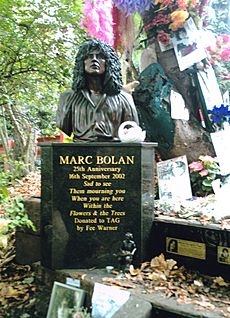
Marc Bolan never learned to drive. He was afraid of dying young. But cars were often mentioned in his songs. He also owned several cars.
On 16 September 1977, Marc was a passenger in a car. His girlfriend, Gloria Jones, was driving. They were going home from a club. The car hit a fence post and then a tree. Marc was killed instantly. Gloria was injured but survived.
The car crash site has become a special place for his fans. They leave tributes there. It is called Marc Bolan's Rock Shrine. The T. Rex Action Group owns and takes care of it.
His funeral was held on 20 September 1977. It was at the Golders Green Crematorium in North London. His ashes were buried there under a rose bush. Many famous musicians attended his funeral. A flower arrangement shaped like a swan was displayed. This was a tribute to his hit song "Ride a White Swan".
There are two plaques at the Crematorium for Marc. One was placed by fans in the 1990s. The other was placed in 2002. It marked 25 years since his death. It says, "25 years on – his light of love still shines brightly". A ceramic white swan is placed below it.
Marc Bolan had set up a trust for his money. This helped his son receive some income.
Discography
For a full list of releases by Tyrannosaurus Rex and T. Rex, see T. Rex discography.
Albums
with John's Children
- The Legendary ... Album (1982)
- Smashed Blocked! (1997)
as Marc Bolan
- The Beginning of Doves (1974)
- You Scare Me to Death (1981)
- Dance in the Midnight (1983)
- Observations (1992)
with Tyrannosaurus Rex
- My People Were Fair and Had Sky in Their Hair... But Now They're Content to Wear Stars on Their Brows (1968)
- Prophets, Seers & Sages: The Angels of the Ages (1968)
- Unicorn (1969)
- A Beard of Stars (1970)
with T. Rex
- T. Rex (1970)
- Electric Warrior (1971)
- The Slider (1972)
- Tanx (1973)
- Zinc Alloy and the Hidden Riders of Tomorrow (1974)
- Bolan's Zip Gun (1975)
- Futuristic Dragon (1976)
- Dandy in the Underworld (1977)
Singles
as Marc Bolan
- 1965 "The Wizard/Beyond the Rising Sun"
- 1966 "The Third Degree/San Francisco Poet"
- 1967 "Hippy Gumbo/Misfit"
with John's Children
- 1967 "Desdemona/Remember Thomas A Beckett"
with Tyrannosaurus Rex
- 1968 "Debora/Child Star"
- 1968 "One Inch Rock/Salamanda Palaganda"
- 1969 "Pewter Suitor/Warlord of the Royal Crocodiles"
- 1969 "King of the Rumbling Spires/Do You Remember"
- 1970 "By the Light of a Magical Moon/Find a Little Wood"
T. Rex
- 1970 "Ride a White Swan/Is It Love/Summertime Blues"
- 1971 "Hot Love/The King of the Mountain Cometh/Woodland Rock"
- 1971 "Get It On (Bang a Gong)/Raw Ramp"
- 1971 "Jeepster/Life's a Gas*"
- 1972 "Telegram Sam/Cadilac/Baby Strange"
- 1972 "Metal Guru/Thunderwing/Lady"
- 1972 "The Slider/Chariot Choogle" (not officially released however some copies exist)
- 1972 "Debora/One Inch Rock/Woodland Bop/The Seal of Seasons(Re-issued)(MagniFly EP)"
- 1972 "Children of the Revolution/Jitterbug Love/Sunken Rags"
- 1972 "Solid Gold Easy Action/Born to Boogie"
- 1973 "20th Century Boy/Free Angel"
- 1973 "The Groover/Midnight"
- 1973 "Truck On (Tyke)/Sitting Here"
- 1973 "Blackjack / Squint Eye Mangle" as Big Carrot
- 1974 "Teenage Dream/Satisfaction Pony"
- 1974 "Light of Love/Explosive Mouth"
- 1974 "Zip Gun Boogie/Space Boss"
- 1975 "New York City/Chrome Sitar"
- 1975 "Dreamy Lady/Do You Wanna Dance/Dock of the Bay"
- 1975 "Christmas Bop/Telegram Sam/Metal Guru" (not officially released however some copies exist)
- 1976 "London Boys/Solid Baby"
- 1976 "I Love to Boogie/Baby Boomerang"
- 1976 "Laser Love/Life's An Elevator"
- 1977 "The Soul of My Suit/All Alone"
- 1977 "Dandy in the Underworld/Groove a Little/Tame My Tiger"
- 1977 "To Know You Is to Love You/City Port"
- 1977 "Celebrate Summer/Ride My Wheels"
- 1977 "Ride a White Swan/The Motivator/Jeepster/Demon Queen"
- 1977 "Get It On/Hot Love (Re-issued)"
- 1978 "Hot Love/Raw Ramp/Lean Woman Blues"
- 1978 "Crimson Moon/Jason B. Sad"
- 1978 "You Scare Me to Death/The Perfumed Garden of Gulliver Smith"
Images for kids
-
Plaque marking Bolan's childhood home, 25 Stoke Newington Common, Hackney.
-
Marc Bolan's Rock Shrine at the site where he died in a car crash in Barnes, London, on what would have been his 60th birthday, 30 September 2007
See also
 In Spanish: Marc Bolan para niños
In Spanish: Marc Bolan para niños


